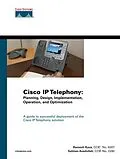This is the eBook version of the printed book. If the print book includes a CD-ROM, this content is not included within the eBook version.
A guide to successful deployment of the Cisco IP Telephony solution
- Real-world case studies from the Cisco design consulting engineers who developed the PDIOO process provide practical advice on all stages of successful IPT deployment
- Concise understanding of the PDIOO phases enables architects and engineers to successfully deploy the Cisco IPT solution
- Division of the process into PDIOO phases provides a logical and defined guide for network engineers and architects as they proceed through each of the phases in deploying the Cisco IPT solution
- Includes detailed questionnaires for each phase of deployment in the PDIOO cycle-a great aid in understanding customer networks and requirements
- Network infrastructure design, call processing infrastructure design and applications, and voice-mail system design are covered in depth
Cisco® IP Telephony (IPT) solutions are being deployed at an accelerated rate, and network architects and engineers need to understand the various phases involved in successful deployment: planning, design, implementation, operation, and optimization (PDIOO). On the road to that understanding, those involved need to collect information for each phase of deployment, and then follow through with the best architecture, deployment model, and implementation based on the data collected.
Cisco IP Telephony: Planning, Design, Implementation, Operation, and Optimization is a guide for network architects and engineers as they deploy the Cisco IPT solution. With this book, you will master the PDIOO phases of the IPT solution, beginning with the requirements necessary for effective planning of a large-scale IPT network. From there, you'll follow a step-by-step approach to choose the right architecture and deployment model. Real-world examples and explanations with technical details, design tips, network illustrations, and sample configurations illustrate each step in the process of planning, designing, implementing, operating, and optimizing a chosen architecture based on information you have collected.
In-depth instruction on each PDIOO phase provides specific details about the tasks involved and best practices for successful implementation of the IPT solution. This book also contains predesigned questionnaires and PDIOO assistance tools that help you determine the requirements of each phase of the PDIOO cycle.
Authors Ramesh Kaza and Salman Asadullah have been involved with Cisco IPT solutions from the beginning and have planned, designed, and implemented major IPT networks using the guidelines found here. Cisco IP Telephony: Planning, Design, Implementation, Operation, and Optimization provides the step-by-step explanations, details, and best practices acquired by the authors while working with the top Cisco IPT customers.
This book is part of the Networking Technology Series from Cisco Press®, which offers networking professionals valuable information for constructing efficient networks, understanding new technologies, and building successful careers.
Autorentext
Ramesh Kaza, CCIE® No. 6207, is a technical leader at Cisco Systems®, providing planning, design, and implementation support in deploying Cisco IP Communications solutions. Prior to working on IP communications, Ramesh was involved in validating the network designs for enterprise and service provider customers. He is a speaker at Cisco Networkers events and has presented the topics "Troubleshooting IPT Networks" and "Designing Large-Scale IPT Networks."
Salman Asadullah, CCIE No. 2240, is a technical leader at Cisco Systems. As a recognized expert within Cisco and the industry, Salman has been designing and troubleshooting large-scale IP and multiservice networks for more than eight years. Salman represents Cisco on industry panel discussions and technical platforms such as NANOG, APRICOT, SANOG, ASEAN, IETF, IPv6 Forum, and Networkers. Salman influences technology directions and decisions with Cisco business units and the Internet community.
Inhalt
Contents
F Foreword
I Introduction
Part I Overview of Technology, Protocols, and the PDIOO Methodology
Chapter 1 Cisco IP Telephony Solution Overview
Legacy Voice and Data Networks
Next-Generation Multiservice Networks
Networks Based on Cisco AVVID
Signaling and Transport Protocols
Telco Signaling Protocols
Analog Signaling
Digital Signaling
VoIP Protocols
H.323
SIP
MGCP
SCCP
RTP/RTCP
IP Telephony Components
Network Infrastructure
Call Processing
CallManager Clustering
Device Weights
Dial Plan Weights
CallManager Directory Services
IP Telephony Endpoints
Cisco IP Phones
SoftPhones
Wireless IP Phones
Voice Gateways
Survivable Remote Site Telephony
Cisco CallManager Express
Call Admission Control
CallManager Locations-Based CAC
Gatekeeper CAC
Fax
Media Resources
Applications
Customer Response Solution
Cisco Unity
Cisco Emergency Responder
Cisco Conference Connection
IP Phone Services
IP Telephony Deployment Architectures
Single-Site Deployment
Centralized Call Processing with Remote Branches
Distributed Call Processing Deployment
Clustering over the IP WAN
Local Failover Deployment Model
Remote Failover Deployment Model
Call-Flow Scenarios
IP Phone-to-IP Phone Call
Intracluster Call
Intercluster Call
Intercluster Call with the Gatekeeper
Off-Net Calls
Using MGCP Gateway
Using H.323 Gateway
Summary
Chapter 2 Planning, Design, Implementation, Operation, and Optimization Overview
Planning Phase
Design Phase
Network Infrastructure Design
Design of Call Processing Infrastructure and Applications
Software Version Evaluation
Design Validation
Implementation Phase
Operation and Optimization Phase
Summary
Part II Large-Scale IPT and Voice-Mail Network
Chapter 3 Large-Scale Enterprise Requirements for IP Telephony
Customer Profile
Data Network Architecture
Voice Network Architecture
Data Applications
Directory and Messaging Architecture
PBX and Voice-Mail System Features
Customer Requirements
System Architecture
IP Phones
Integration and Replacement of Legacy PBX Systems
Integration and Replacement of Legacy Voice-Mail Systems
Voice Gateways
Quality of Service
Call Routing
Emergency Services
IPT Features and Applications
Security
Redundancy and High Availability
Network Management
Return on Investment
Summary
Chapter 4 Planning Phase
Getting Started
Network Infrastructure Analysis
Campus Network Infrastructure
Access Layer
Distribution Layer
Core Layer
Ca…
